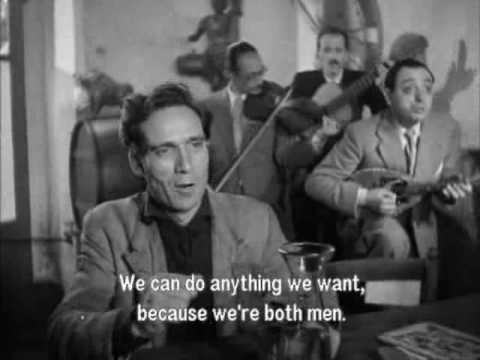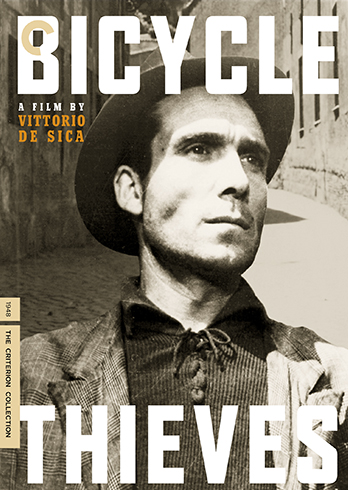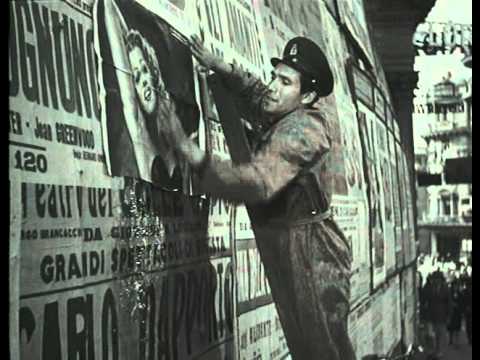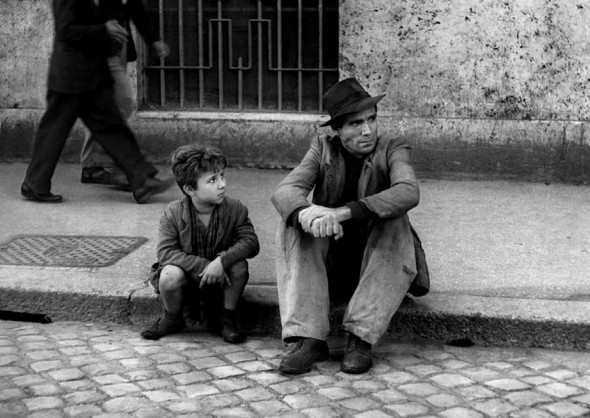Bicycle Thieves film (Italian: Ladri di biciclette), also known as The Bicycle Thief, is director Vittorio De Sica’s 1948 story of a poor father searching post-World War II Rome for his stolen bicycle, without which he will lose the job which was to be the salvation of his young family.

Watch this video on YouTube
The Bicycle Thief, trailer.
Gritty Realism of Poverty in Post-War Italy
Italian neorealism endeavored to move filmmaking away from the stilted, contrived (and popular) national cinema that had formed under Fascism, but also counteracted the distorted narratives of Hollywood. With its biting social conscience and deliberate shunning of studio filmmaking in favor of gritty realism, it deals with alienation under the harsh economic conditions of post-war Rome.

Watch this video on YouTube
Restaurant Scene


From André Bazin: Ladri di Biciclette is certainly is neorealist, by all the principles one can deduce from the best Italian films since 1946. The story is from the lower classes, almost populist: an incident in the daily life of a worker. But the films show no extraordinary events such as those which befall the fated workers in [Jean] Gabin films.
There are no crimes of passion, none of those grandiose coincidences common in detective stories which simply transfer to a realm of proletarian exoticism the great tragic debates once reserved for the dwellers on Olympus. Truly an insignificant even a banal incident: a workman spends a whole day looking in vain in the streets of Rome for the bicycle someone has stolen from him. This bicycle has been the tool of his trade, and if he doesn’t find it he will be again unemployed.
One must take care not to confuse it with realist tragedy in the [Jacques] Prévert or James Cain manner, where the initial news item is diabolic trap placed by the gods amid the cobble stones of the street. In itself the event contains no proper dramatic valence. It takes on meaning only because of the social (and not psychological or aesthetic) position of the victim. Without the haunting specter of unemployment, which places the event in the Italian society of 1948, it would be an utterly banal misadventure.
Likewise, the choice of a bicycle as the key object in the drama is characteristic both of Italian urban life and of a period when mechanical means of transportation were still rare and expensive. There is no need to insist on the hundreds of other meaningful details that multiply the vital links between the scenario and actuality, situating the event in political and social history in a given place at a given time.

Watch this video on YouTube
Ladri di Biciclette – Scene, by Vittorio de Sica
While popular culture has had a tendency to romanticize Italian Neorealism, the same way it has with the French Nouvelle Vague, but history has judged films such as Bicycle Thieves, along with those of Roberto Rossellini and a young Federico Fellini, as influential and inspiring to directors such as Martin Scorcese, Woody Allen, Stanley Kubrick, Wang Xiaoshuai, and Pier Paolo Pasolini.


| Director | Vittorio De Sica |
| Screenplay | Vittorio De Sica, Suso Cecchi D’Amico, Gerardo Guerrieri and Cesare Zavattini |
| Cinematography | Carlo Montuori |
| Producer | Giuseppe Amato and Vittorio De Sica |
| Story | Cesare Zavattini |
| Based on a novel by | Luigi Bartolini |
Updated 26 March 2023












